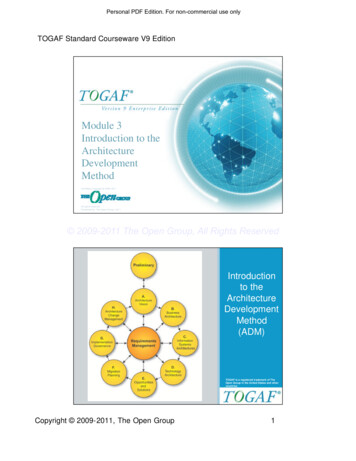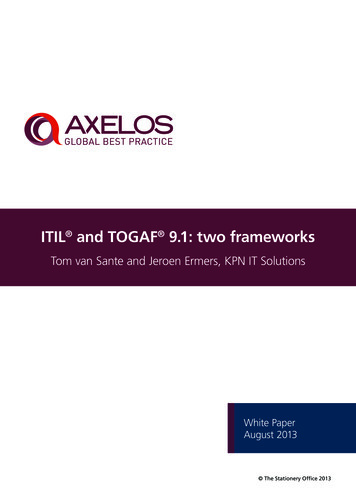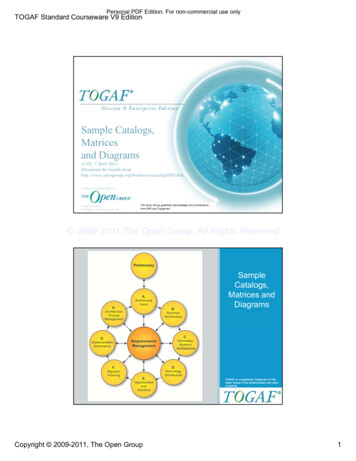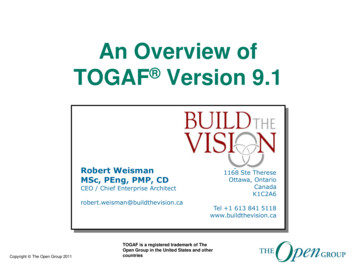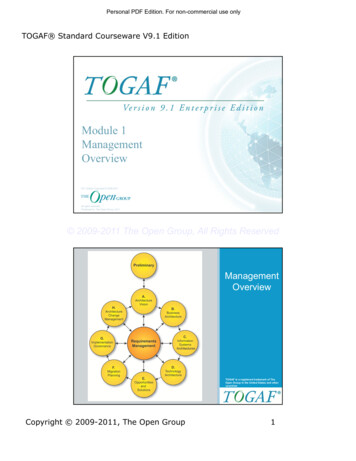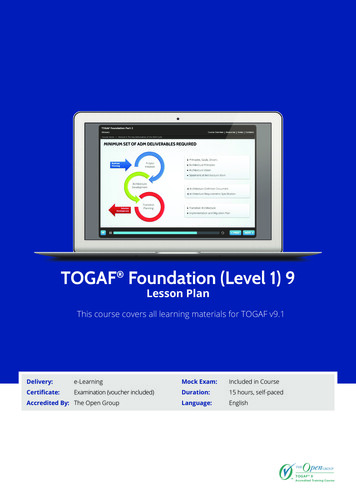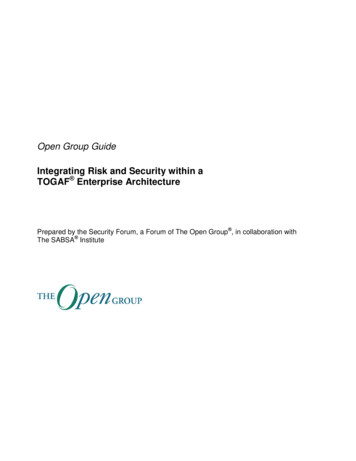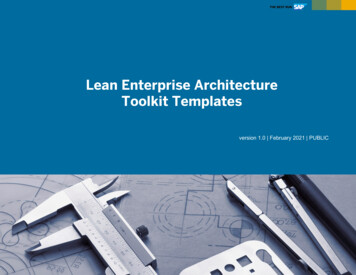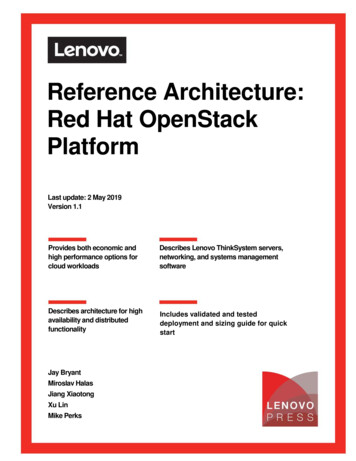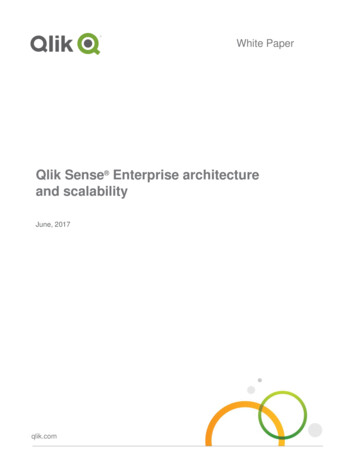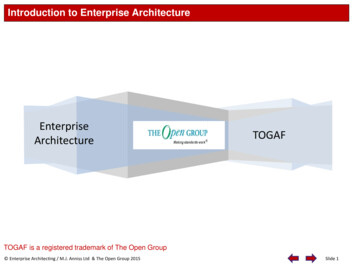
Transcription
Introduction to Enterprise ArchitectureEnterpriseArchitectureTOGAFTOGAF is a registered trademark of The Open Group Enterprise Architecting / M.J. Anniss Ltd & The Open Group 2015Slide 1
Purpose This introduction to Enterprise Architecture provides the context for enterprisearchitecture and information about effective architecture practice. Enterprise Architecting / M.J. Anniss Ltd & The Open Group 2015Slide 2
The Foundations Of An Architectural ViewAn enterprise is any collection of organisations that has acommon set of goals. For example, an enterprise could be agovernment agency, a whole corporation, a division of acorporation, a single department, or a chain of geographicallydistant organizations linked together by common ownership.An extended enterprise frequently includes partners, suppliers,and customers. If the goal is to integrate an extendedenterprise, then the enterprise comprises the partners,suppliers, and customers, as well as internal business units.Enterprise Architecture is:1. A conceptual structure used to develop, implement and sustain anenterprise architecture.2. The organising logic for business processes and IT infrastructurereflecting the integration and standardisation requirements of anorganisation's operating model.3. A blueprint that defines the structure and operation of anorganisation. The intent of an enterprise architecture is todetermine how an organisation can most effectively achieve itscurrent and future objectives.An architecture is a formal description that provides the basis for arranging a system at a component level to guide its implementation,such that the things within the system and the other systems that it interacts with operate in an effective manner. An architect’s role istherefore to manage the structure and change in an enterprise to optimise effective operation.The challenge is how to achieve this. This is further complicated by the issue of what constitutes an effective manner and who decides whateffective means. Architects therefore have to deal with structure, components, opinions, politics and power in order to steer an enterprisetowards an effective (usually evolving) architecture.An enterprise architect works with the overall requirements / constraints of the enterprise to drive and govern the development of the(usually evolving) enterprise architecture; providing a balance of the general/global and specific/local outcomes required by that enterprise(at the relevant strategic, segment and capability levels - TOGAF terms).A solution architect works with a set of specific requirements/constraints to deliver specific solutions; providing a balance between theneeds of those specific requirements/constraints with the agreed wider enterprise architecture (at the relevant strategic, segment andcapability levels). Enterprise Architecting / M.J. Anniss Ltd & The Open Group 2015Slide 3
The Foundational Problem Of The Architect’s RoleManaging Global vs Local OptimisationAny solution (at the strategic, segment or capabilitylevel) will have to balance its specific impact for aparticular actor and on a specific component with thewider impact on all of the other actors and componentswithin the enterprise.ChannelsOne of an architect’s unique responsibilities is to bringout this conflict, explain the issues, and work withothers in the business the shape the delivered solutionto do the best combination of greatest benefits and leastharms.ChannelsPresentation & Session Layer Presentation Layer Package It is almost never the case that the optimum outcomefor a one local viewpoint is the same for other localviewpoints or the global viewpoint.Actor 3Actor 2Actor 1 Presentation Layer Package Presentation Layer Package Business Process LayerPackage Business Process LayerPackage Business Function LayerPackage Business Function LayerPackage Business Process Layer Business Process LayerPackage Business Function Layer Business Function LayerPackage Example: Sales in a regulated environment such as the drug industry.Actor 1 is in sales and wishes to change a component, removing what they see as redundant steps and checks to speed up the salesprocess and increase yearly revenue.Actor 2 is in compliance and wishes to add new steps and checks to ensure compliance to new traceability regulations, required to operatein the market without penalties.Each individual set of requirements wants to make different changes to business process, applications and data. The enterprise andsolution architects’ role is to recognise the conflict and help to broker a solution that achieves the right balance. Note that there may bemany cases where political power within the enterprise drives the chosen solution rather than optimal overall outcomes. Enterprise Architecting / M.J. Anniss Ltd & The Open Group 2015Slide 4
Architecture / Architects vs Design / DesignersThe difference between the practice and roles of architecture/architects and design/designers is not always clear. In reality there are manyoverlaps and many people perform both or some of both roles.Architecture without design (specific implementation and practice) is slide ware, while design without architecture (context and scope)delivers cul-de-sacs and closed off local optimisations.Architecture and design operates at all three levels of enterprise architecture - strategic, segment and capabilityArchitectsDesignersArchitects focus more on the abstract and logical; strategy,purpose and structure.Designers focus more on the concrete and physical; implementationand practice.So who is Enterprise Architecture for:Enterprise, Business and IT Architects at all levels who construct and govern architecture building blocks (ABBs) to enable the creation ofeffective solution building blocks.Business and IT Designers at all levels who need to design solution building blocks (SBBs) and must work within defined architectures.Programme and project managers who lead projects that develop architecture and solution building blocks. Enterprise Architecting / M.J. Anniss Ltd & The Open Group 2015Slide 5
Positioning Architecture - Four Main Views Of An OrganisationOrganisations are driven from four main views, that reflect the goals, change, structure, actions of andoutcomes for that organisation.New opportunity and change programmeimpacts on strategy and planningStrategyStructure and integration impacts onstrategy and planning(Defining the projection for the future)Organisation vision andgoals for the futureOrganisation vision andgoals for the future.Opportunities andrequests for changeR&D / TransformationArchitecture(Moving the organisation forward)(Structuring and integratingthe organisation and its assets)Enablers, constraints forand outcomes of changeOperational requirementsand constraints for changeChangeprogrammeimplementationEnablers andconstraints foroperationOperational requirementsand constraints for structureand integrationOperations(Running the organisation) Enterprise Architecting / M.J. Anniss Ltd & The Open Group 2015Slide 6
Why Enterprise Architecture Is ImportantAll enterprises have an architecture, which isthe set of and arrangement of its resourcesand the manner in which they work together.An enterprise can manage that architectureinformally or it can document it and formallymanage it.Small and relatively simple organisations canoften afford to ignore the architecture andmanage in a gut feel, holistic fashion.As organisations become larger and morecomplex the interactions, dependencies andconnections between their internal and externalresources create many different effects andneed to managed at a number of levels andfrom a number of different perspectives.The ability of an organisation to structure, control, manage and change theirresources depends on: The information that is held about the resources The accuracy and completeness of that information The processes that ensures the on-going management and control of thatinformation The organisation’s ability to use that information effectively to make gooddecisions about change in support of the business goals that are supported bythese propertiesEnterprise architecture provides the basis for defining and then managing anorganisation’s resources, their interactions and their outcomes. An enterprisearchitecture is a model of an organisation’s business assets that reflects: The current state of those assets and their interaction The target state of those assets and their interaction The transitional states as transformation and change programmes and projectsare implementedHaving effective documentation of these perspectives enables an organisation toachieve enterprise alignment and integration in order to manage change, optimisecost and value, improve quality and satisfaction, and reduce “time-to-market”. Enterprise Architecting / M.J. Anniss Ltd & The Open Group 2015Slide 7
Enterprise Architecture Helps To Manage ComplexityAchieving agreement across an organisationabout these connections, interdependenciesand constraints is difficult.Finding time to define and mange the enterprise architecture itself and itsimplications is not easy. Operational managers tend not to have the time to forthis and only become involved with it when they:Most business managers are primarily focusedon running their existing business processes. They are usually measured on immediateexploitation of those business process;rather than the overall management of theprocesses themselves over time. This makes it difficult to enable theorganisation to grow, change and improve inline with the strategic direction set by theexecutive.Enterprise architecture provides a basis forunderstanding all of the resources in anorganisation and considering both theimmediate tactical and future strategicimplications. Have a failure or a problem Wish to do something they have not done before Have a failure of problem in using their existing resources to achieve theirgoals Have to deal with negotiation, boundary, transition, alignment issuesIt is usually only when these problems arise that the underlying architecture of anorganisation becomes visible.It is similar to the attention we apply to plumbing or electricity system, weassume it all works until it fails.The benefits of good architectural definition and control can thus be difficult tojustify to the business over the short term.However, dealing with complex operational problems and achieving strategic goalsrequires a good understanding of the architecture of an organisation and how toevolve it in line with a careful balancing to tactical and strategic goals andoutcomes. Enterprise Architecting / M.J. Anniss Ltd & The Open Group 2015Slide 8
Enterprise Architecture Address Structure and InteractionEnterprise architecture identifies themain structures within an organisationand how they interact.In a “technical sense” it is about theelements (resources) within anorganisation and their: PropertiesElementsInteractionsBoundaries Arrangement Boundaries Interactions and relationshipsDifferent parts of an organisation oftenhave different and conflicting goals andpractices that need to operate togetherin a collective ecosystem.The purpose of enterprise architectureis to optimise across the enterprise theoften fragmented legacy of processesand resources (both manual andautomated) into an integratedenvironment that is responsive tochange and supportive of the deliver yof the business strategy.Enterprise architecture provides the blueprint, plan or model and the management practicesto more actively and effectively manage the complexities within an organisation by facilitatingthe: Definition of the resources within a business Definition of the boundaries and relationships between these resources Negotiation and management across these boundaries Management of the shared processes and systems across these boundaries Establishment of trust across these boundaries Establishment of responsibilities for resources within the business Governance for those resources from the perspective of the complete businessecosystem. Enterprise Architecting / M.J. Anniss Ltd & The Open Group 2015Slide 9
Different Contexts For ArchitectureCity planning is an often used analogyfor enterprise architecture. In simpleterms a city can be considered tohave at least three organisingcontexts.City / EnterpriseBuilding / ComponentDistrict / Domain City (Enterprise)The structures and integrationneeded across the whole city(sewers, roads etc.). District (Domain/Segment)The structures and integrationneeded to manage the district andits buildings and integrate backinto the city wide structure. Building (Component/Capability)The structures needed to deliverthe specific properties of thebuilding and integrate back intothe district structure.The City Planning AnalogyDifferent capabilities are planned and managed at the different levels . Roads, sewers, water pipes electricity grids tend to be planned across the city Types of activity, (business, leisure, housing) are often “zoned” into specific districts. Individual buildings are then designed within these contexts and to meet their specificrequirements.City planning sets the context and the basis for integration for district and building planning. Enterprise Architecting / M.J. Anniss Ltd & The Open Group 2015Slide 10
The Benefits Of Enterprise ArchitectureTo manage an enterprise we therefore need tocreate: An understanding/model of the resourcesavailable to the enterprise A set of activities that utilise thatunderstanding/model to make betterdecisions about those resources and how thyare usedThis provides the basis for managing change toan enterprise and delivering business benefit: Specifically via a business case for eachchange More generally through wider rationalisation,reuse, cost reduction, simplification andspecialisation of the business resources.Enterprise architecture provides the models andprocesses for this.The deliverables from an effective enterprise architecture are: A clear, well documented definition of the current state of an organisation’sresources. Well defined current, transition and target architectures that provide thecontext for change and speed decision making and impact assessments. Reusable and standardised components within the architecture that drivecost reduction and quality improvements. An understanding of the relationship between planned change and currentoperation that minimises implementation errors for each change project. A clear architectural view and high level design for each specific change thatimproves the ability to assess costs, risk and impact before the change isbudgeted and approved.The benefits from an effective enterprise architecture are:Better knowledge and management of business assets and their interaction,reducing the cost of change and enabling that change to be implemented: Individually with less risk and more speed Collectively with improved alignment: Enterprise Architecting / M.J. Anniss Ltd & The Open Group 2015–Between each change initiative–To business strategy and goalsSlide 11
Key Concepts In TOGAF Enterprise Architecting / M.J. Anniss Ltd & The Open Group 2015Slide 12
Who Are The Open Group?L1 / L2The Open Group is a consortium. It was founded in1996 when X/open merged with the OSF.It’s initial focus was on technical standards such asUNIX/POSIX, CORBA, WAP, ODBC, LDAP.It now focuses on open standards and the flow ofinformation across organisations.One of the standards is the Open Group ArchitectureFramework (TOGAF).The Open Group covers a diverse group that spans allsectors of the ICT community ICT customers, systemsand solutions suppliers, tool vendors, integrators andconsultants, as well as academia and researchers.There are 250 member organisations come from all over the world; 50% from North America, 25% from Europe, and 25% from Asia-Pacific.These include Capgemini, Fujitsu, Hewlett-Packard, Hitachi, IBM, PWC, US Department of Defence and NASA.Many government departments and agencies use TOGAF particularly in Europe, and the US. Enterprise Architecting / M.J. Anniss Ltd & The Open Group 2015Slide 13
An Overview Of TOGAF Enterprise Architecting / M.J. Anniss Ltd & The Open Group 2015L1 / L2Slide 14
The Architecture FrameworkL1 / L2The Open Group Architecture Framework (TOGAF) isa tool for assisting in the acceptance, production,use, and maintenance of enterprise architecturesIt is based on an iterative process model supportedby best practices and a re-usable set of existingarchitectural assets.It is developed and maintained by The Open GroupArchitecture Forum.The first version of TOGAF, developed in 1995, wasbased on the US Department of Defence TechnicalArchitecture Framework for InformationManagement (TAFIM).It has also incorporated elements from most of theother major architecture approaches from across theindustry (e.g. Zachman, DODAF, MODAF, FEAF) intoan overall consistent framework and developmentprocess.–T Enterprise Architecting / M.J. Anniss Ltd & The Open Group 2015Slide 15
The Four Major Viewpoints Of The Architecture FrameworkThe latest version, TOGAF 9, was introduced in 2009.It can be used for developing a broad range ofdifferent enterprise architectures. TOGAFcomplements, and can be used in conjunction with,other frameworks that are more focused on specificdeliverables for particular vertical sectors such asGovernment and Telecommunications. TOGAF is A framework, not an architecture A generic framework for developing architecturesto meet different business needs Not a “one-size-fits-all” architecture Focuses on business IT alignment Based in best practices Widely adopted in the market Tailorable to meet an organisation and industryneedsIt is broken down into phases that have a continuousflow into each other as an organisation evolves itscapability and the associated architecture views.The specific architectural elements within TOGAF are: Business architecture Information systems architecture Technology architecture Enterprise Architecting / M.J. Anniss Ltd & The Open Group 2015L1 / L2PreliminaryUnderstanding your capabilityand setting the contextCreating ,implementing& l choice ofsolution building blocksand implementation de 16
Document Deliverables Around the Lifecycle (Outputs)Each phase cangenerate a setof deliverablesto help managethe evolution ofthe enterprisearchitectureand eachspecific changeintroduced intotheorganisation.Business Principles, Goals & DriversRequest For Architecture WorkOrganisation Model For Enterprise ArchitectureArchitecture RepositoryTailored Architecture FrameworkGovernance FrameworkArchitecture PrinciplesArchitecture ture UpdateSigned Architecture ContractSolution Building BlockCompliance AssessmentArchitecture Compliant SolutionGovernance FrameworkChange RequestRequest For Architecture WorkFinal Architecture Definition DocumentFinal Architecture Requirements Spec.Final Architecture RoadmapFinal Transition ArchitectureDraft Architecture ContractImplementation & Migration PlanImplementation & Migration StrategyImplementation Governance ModelFinalised Architecture Building BlockChange nGovernanceFMigrationPlanningApproved Statement of Architecture WorkCommunications PlanTailored Architecture FrameworkArchitecture VisionArchitecture PrinciplesCapability AssessmentVision Architecture Definition DocumentVision Architecture Requirements SpecificationVision Candidate **EOpportunities&SolutionsL1 / L2Approved Statement of Architecture WorkDraft Architecture Definition Document (Business)Draft Architecture Requirements Spec. (Business)Business Architecture PrinciplesCandidate rchitectureApproved Statement of Architecture WorkDraft Architecture Definition Document (IS)Draft Architecture Requirements Spec. (IS)IS Architecture PrinciplesCandidate RoadmapApproved Statement of Architecture WorkDraft Architecture Definition Document (Technology)Draft Architecture Requirements Spec. (Technology)Technology Architecture PrinciplesCandidate RoadmapArchitecture RequirementRequirements Impact Assessment**Approved Statement of Architecture WorkDraft Architecture Definition DocumentDraft Architecture Requirements Spec.Consolidated Architecture Roadmap ( ) Transition Architecture(Initial) Implementation & Migration Plan(Initial) Implementation & Migration Strategy Enterprise Architecting / M.J. Anniss Ltd & The Open Group 2015Slide 17
The Content Framework Metamodel Enterprise Architecting / M.J. Anniss Ltd & The Open Group 2015L1 / L2Slide 18
Example Specific Architecture Artefacts In The Content Framework L1 / L2Preliminary Enterprise Architecting / M.J. Anniss Ltd & The Open Group 2015Architecture VisionSlide 19
Making Sense Of The Capabilities and Layering The TOGAF content frameworkdifferentiates between theprocesses of a business and theservices of a business.–– Business services arespecific processes thathave explicit, definedboundaries that areexplicitly governed.Services are distinguishedfrom processes throughthe explicit definition of aservice contract thatdefines a post conditionand it performanceattributes.The granularity of businessservices should be determinedaccording to the businessdrivers, goals, objectives, andmeasures for this area of thebusiness. Finer-grained servicespermit closer management andmeasurement (and can becombined to create coarsergrained services), but requiregreater effort to govern.L1 / L2Identify which specific abilities a business should rovide the context for choosing which services to Business Servicesprovide the contractualterms for the execution ofprovide the context forand sequencing ofProcesses(Activities)managethe state ofEntities(Objects)Procedures(Algorithms)identify the processing required bymay invokeIS / Application ServicesPhysicaloperationslayerprovide theexecutionplatform for Enterprise Architecting / M.J. Anniss Ltd & The Open Group 2015ApplicationComponentschange thestate ofrequire form/Technology/Infrastructure ServicesTechnology ComponentsSlide 20
Completing The Business Architecture View (POPIT)L1 / L2Identify which specific abilities a business should rovide the context for choosing which services to offerBusinessmanagementlayerBusiness Servicesprovide the contractualterms for the execution ofprovide the context forand sequencing ethe state ofEntities(Objects)Procedures(Algorithms)identify the processing required bymay invokeIS / Application ationComponentsOrganisation(Structures)Facilities and NonComputing Technologyprovide theexecutionplatform for Enterprise Architecting / M.J. Anniss Ltd & The Open Group 2015change thestate ofrequire form/Technology/Infrastructure ServicesTechnology ComponentsSlide 21
Good Architecture Practice Enterprise Architecting / M.J. Anniss Ltd & The Open Group 2015Slide 22
Choosing An Approach For Enterprise ArchitectureAn enterprise architecture needs to beorganised to support effective definitionand management. As an organisation: Changes its motivation (vision, strategyand goals) A series of changes may be required tothe resources within the enterprise. A set of guidelines to manage thatchange in a coordinated and consistentfashion is requiredMotivationChangeGuidelines & Controls For ectureTechnologyArchitectureAn enterprise architecture provides a structure within which the resources subject to change can be identified, viewed and modified toachieve the best balance of longer term strategic and immediate tactical outcomes. The most widely used approach for managing anenterprise architecture is The Open Group Architecture Framework (TOGAF).TOGAF’s initial organising concept is the grouping of business resources into three specific sets. Business architecture - organisation structure, operating model, party/people, processes, information Information systems architecture - systems, applications and data Technology architecture - computing & network devices, software products, other physical and technologies Enterprise Architecting / M.J. Anniss Ltd & The Open Group 2015Slide 23
The Evolution Of An Enterprise ArchitectureAn enterprise architecture is not staticbut changes over time. This can beviewed as a series of state definitionsrepresenting: A current/baseline architecture (thecurrent state) Transition architectures (steps on thepath towards the target architecture) A target architecture (the futuredesired state)Motivationprovidesthe basis forbecomes thenext current stateChangeshapes the transitionarchitecturesCurrentArchitectureis built uponto createbecomes the nextcurrent stateprogresses towardsthe targetTransitionArchitecturescontrol the natureand implementationof the changeTargetArchitecturechanges over time asprogress is madetowards it and newchange emergesGuidelines & Controls For ectureTechnologyArchitectureThe concept of a current/baseline, transition and target state applies to all of the components within an enterprise architecture. Eachorganisation decides which components to formally manage and may create a series of change roadmaps. The most commonly foundroadmaps tend to be for: Technology and application evolution (sometimes combined as platforms) Business, software and physical service evolution Process evolution Enterprise Architecting / M.J. Anniss Ltd & The Open Group 2015Slide 24
Identifying Solution Requirements And Specification PropertiesArchitecture and design requires anunderstanding of the desiredproperties of the solution; asexpressed in the requirements andthen in the specification (that it isagreed can be developed to best[often not completely] meet thoserequirements).The table to the right shows thedifferent types of requirements thatmay be either explicitly or sIt is rare that all of these arespecified in the requirements but allof these will have a performancelevel in the final solution.Architecture and design activity mustensure that the performance levelsfor these properties are understoodand the agreed performance levelsare delivered by all of the solutioncomponents working together.End UserConcerns Enterprise Architecting / M.J. Anniss Ltd & The Open Group Action/TaskDeliverability(Time - echnologyClarity sClarity lityConsistencyVisibility abilitySlide 25
Matching The Requirements And Solution Specification PropertiesThe list on the left shows theproperties that are initiallyrequested.It is often not possible to meet all ofthese within the same architecture /design (e.g. a requirement to deliverrecoverability may conflict with onefor responsiveness).Customer / service / productsolution requirementproperties that may becontradictory betweenthemselvesDifferent existing component /supplier properties that may meetsome or all of the required solutionpropertiesThe lists to the right show propertiesof the different solutions that may beable to meet some or all of thoserequirements. There will be fewcases where there is a perfect matchbetween the properties of therequirements and the properties ofthe solutions.Architecture and design is the act ofbalancing the requirements to reflectpossible combinations and thenmatching them to the properties ofpotential solution components. Enterprise Architecting / M.J. Anniss Ltd & The Open Group 2015One of the possible sets of realimplementable properties has to bechosen.Slide 26
Architecture And Design Is A Series Of Trade OffsAs architecture and designprogresses the differences andcontradictions between the desiredand available properties emerge.RequirementsArchitecture and design is thereforeoften a process of trading off theperformance of differentrequirements and the ability ofdifferent potential solutions to bestmeet those requirements.Current Architecture& Design GuidelinesHigh LevelArchitectureand design isSolutiona process ofDesigntrade offbetween therequirements and thepotentialexisting,Detailed uirableCapabilitiesCreatableCapabilitiesSolution IntegrationTest & ConfirmOutcomes Enterprise Architecting / M.J. Anniss Ltd & The Open Group 2015Slide 27 pag
Enterprise Architecting / M.J. Anniss Ltd & The Open Group 2015 Slide 1 Introduction to Enterprise Architectur
